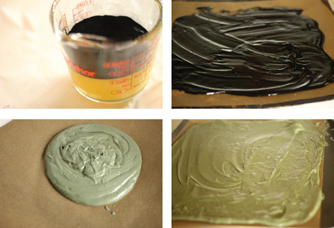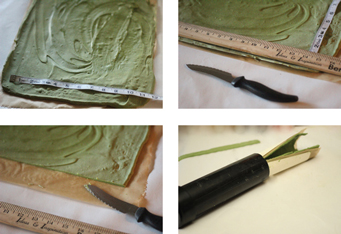
This is a delightful soap to make, using real juicy watermelon which has incredible benefits for the skin! This soap is a two- (almost three-) fold process, so you will be making two separate batches on two different days. The first day you will craft one full batch of soap which will be split into two separate yet equal amounts, one will be used to make watermelon “seeds” the other will be the “rind”. Let’s get started! (This recipe will make a 40-oz round block of soap.)
Additional supplies:
3- x 16-inch round tube with 1 cap (I got mine from the hardware store in the pipe section.)
1 piece flexible cardstock (60 lbs/162 gsm)
Ingredients:
Day 1
7.6 oz watermelon
2 tbsp olive oil
1 tsp titanium dioxide
6.6 oz distilled water
2.91 oz lye
8 oz olive oil
8 oz coconut oil
4 oz castor oil
2 tsp charcoal (for watermelon “seeds”)
2 tsp chlorella (for watermelon “rind”)
1 teaspoon (or more as desired for color depth) titanium dioxide
1 teaspoon (or more as desired for color depth) red iron oxide
Day 2
frozen 7.6 oz watermelon from previous day
2.91 oz lye
2 tbsp olive oil
8 oz olive oil
8 oz coconut oil
4 oz castor oil
a little extra olive oil to mix colorants
1 teaspoon (or more as desired for color depth) titanium dioxide
1 teaspoon (or more as desired for color depth) red iron oxide
Recommended essential oils for fragrance:
90 drops of wood, 5 drops of frankincense, and 3 drops benzoin
Recommended Scent Blend
This scent is very straightforward and is a wonderful watermelon doppelgänger.
• 150 drops ho wood
• 10 drops frankincense
• 6 drops benzoin
SAFETY CHECK!
Since watermelon has lots of sugar, it will be necessary to freeze the liquid before blending it with your lye or the sugar will burn, affecting the overall color and scent of the soap.
Cut the watermelon off the rind and into little chunks; you will only need about 6.6 ounces so you can enjoy eating the rest!
Place the watermelon into your blender and blend until it reaches a liquid puree consistency. Pour this liquid into ice cube trays and freeze.
Cover two cookie sheets with parchment paper. Take 2 tablespoons of olive oil and mix with 1 teaspoon of titanium dioxide. Set aside.

Weigh 7.6 oz of distilled water in a heatproof bowl, and in a separate container, weigh your lye. Take these to a well-ventilated outside area and add your lye to your distilled water, mixing thoroughly. Set this aside in a safe place to cool.
Now weigh your oils and melt over medium heat. Remove from heat when melted. Once your oils and lye water both reach around 100°F to 110°F, add the lye water to the oils and blend until trace is just reached. Now split your blend into two bowls.
In one bowl, add 2 teaspoons of charcoal. Mix until thoroughly incorporated and just before pudding state is achieved. Pour this blend onto a lined cookie sheet and move your soap around until you have about a ¼-inch-thick layer. These will be your watermelon “seeds.” Set aside, uncovered, to harden for 12 to 24 hours.
Next, add your titanium dioxide/oil mix and 2 teaspoons chlorella to the second bowl of soap. Mix until color is incorporated and just before pudding thickness is reached. Pour this blend into your second cookie sheet, spread it out to about ¼- to ⅛-inch thick. Don’t worry about perfection here.
Set this aside for about 12 hours. This will be the watermelon “rind.”
The next day, or at least 12 hours later if you’re truly committed to finishing the same day, weigh 7.6 ounces of watermelon ice cubes in a heatproof container. Weigh 2.91 ounces lye in a separate container. In a well-ventilated area outside, add your lye to your watermelon ice cubes and mix thoroughly. Set aside in a safe area to cool.


Take your now-solid sheet of black soap and pull this off your parchment. Cut into little seed-sized bits and set aside.
Measure 9 inches across the width of your green sheet of soap. Now, cut so you have straight edges on each side and top and bottom, 9 inches across and about 12 inches long. Peel this sheet of soap off the parchment paper and gently place onto a fresh piece of parchment, making sure what will be your bottom end will be flush with the edge of the parchment. Trim off edges of excess parchment along the side so it lines up evenly with the sides of your soap sheet; however, leave excess parchment along the top—this is what you will use to pull your finished soap from the tube after it has set. Now place your cardstock behind the parchment so you have a flexible yet solid backing. Gently roll up your soap sheet with the soap on the inside and the cardstock on the outside and slide this into your tube, which has been capped at one end. Set aside.

Mix 2 tablespoons of olive oil and add 1 teaspoon titanium dioxide until blended and set aside. Weigh and melt your oils over medium heat. Remove from heat once melted and add scent if desired. Add your watermelon/lye mix once oils and lye both reach 90 degrees. Mix. Add titanium dioxide mix and 1 to 2 teaspoons red iron oxide. Mix until trace is reached and mix a bit longer so this blend will sustain the “seeds” without them sinking.

Add seeds, as much or as little as you’d like. Stir these in and pour this mixture into your prepared “rind”-lined tube. Set aside for 12 hours, then cut your beautiful watermelon soap. Set out to cure in an undisturbed spot for 4 weeks. Hooray, watermelon soap!
Watermelon for the Skin
The antioxidants in watermelon help reduce the signs of aging while creating healthy collagen and balanced sebum production.
Watermelon reduces blemishes, soothes and heals sunburns, and removes dead skin cells to reveal healthy glowing skin underneath. It nourishes skin with vitamins C and A, b6 amino acids, and lycopene.
Watermelon is incredibly great for the largest organ of your body. Scrub your outsides down with this soap for a lusciously moisturizing and luxurious cleansing experience.